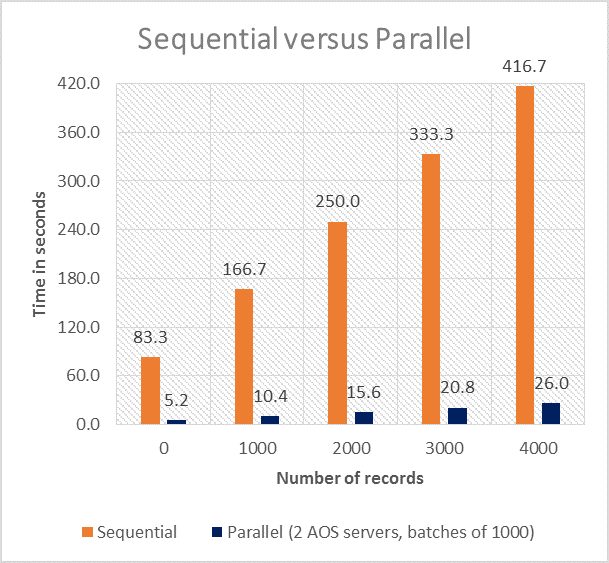Do you need to import data from your business or legacy systems into Microsoft Dynamics AX 2012, the ERP system? At To-Increase, we, our partners and customers deal with data migration concerns every day. Successful data migration requires a scalable, efficient tool that minimizes any downtime of your data and applications and that also ensures optimal data quality. We built such a tool: To-Increase Data Migration Studio for Microsoft Dynamics AX 2012. It’s one of our Business Integration Solutions. Today we take a look at how the scalability of Data Migration Studio helps to reduce downtime.
Parallel Data Import:
Data Migration Studio's main scalability feature is the ability to import data in parallel. This gives you the opportunity to balance the load across multiple Application Object Servers (AOS). Each AOS has eight threads available for processing.
Imagine you need to import 5,000 records. When you run this import in sequential mode for the first time, it will process 12 records per second. The import will run for approximately seven minutes. Now, let us split the data into five chunks of 1,000 records each. Run the same import again, this time in parallel on two AOS. The system is now processing 192 records (2 * 8 * 12) per second, significantly speeding up data migration. The chart below illustrates the difference between sequential and parallel data import processing in terms of seconds and number of records.

This is just a theoretical example, but the concept proves to be valid in practice. Last year, for example, one of our customers, Hardi International, a maker of agricultural sprayers, completed a data migration to Microsoft Dynamics AX 2012. The company’s IT managers experimented with sequential and parallel data imports using Data Migration Studio. When they ran the import sequentially, it took six hours to import 396,449 records. A parallel import with the load spread across three AOS took just 18 minutes.
Data Migration Feature:
In the new release of Data Migration Studio, we introduced a new migration feature. By using the migration feature, you can configure a mapping from a source to a target in a single step. A migration defines the import mapping between the source and Microsoft Dynamics AX 2012 data model. The figure below shows the simple concept behind the migration feature.
The migration feature enables scalability because you can now import data directly into the Microsoft Dynamics AX tables. A temporary or staging table is not required anymore. Updates in the Microsoft Dynamics AX data model do not require a common intermediate language (CIL) compile, and the data model is directly reflected in the mapping of the migration.
Data Migration Templates:
Data Migration Studio supports configuration templates. This capability is very powerful if you need to migrate multiple sites and systems to Microsoft Dynamics AX 2012. As a consultant or ERP implementation manager, you can simplify and accelerate your customer’s data migration from Baan, SAP, or other applications with the templates you prepare.
In a future blog post, we will show you how Data Migration Studio ensures best data quality.
If you have any questions regarding this blog post or Data Migration Studio, please contact us.





